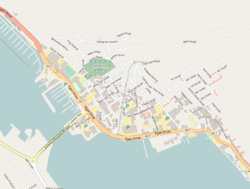
The Alaskan Hotel and Bar, also known as the Northlander Hotel and The Alaskan, is a historic establishment and the oldest operating hotel in Juneau, Alaska. It was opened in 1913. The owners, three miners who struck it rich in the nearby Coast Range, tied the hotel's keys to a helium balloon and released it, signifying that the hotel would never close. The building was briefly condemned in the 1970s, but was rehabilitated by the new owners.
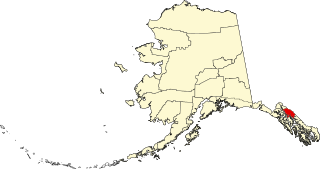
This is a list of the National Register of Historic Places listings in Juneau, Alaska.

J.S. Schroeder Building is a historic commercial building located at 111 North Walnut Street in the Downtown Historic District of Peabody, Kansas, United States. It was listed on the National Register of Historic Places (NRHP) on December 6, 1991.
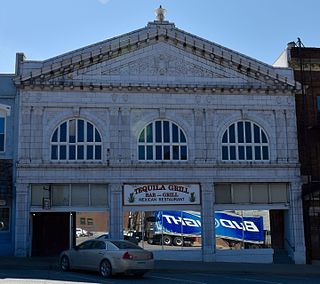
The Benson Block is a historic building located in downtown Ottumwa, Iowa, United States. It is two-fifths of a building that was originally constructed in 1883 and was damaged in a fire in 1923. This part of the building was re-constructed as a theatre, but because it lacked a sufficient number of exits, was never used for that purpose. It is noteworthy for the decorative Neoclassical white terra cotta cladding on the façade, which enabled its owners to transform its original appearance. The building was listed on the National Register of Historic Places in 1985. In 2016, it was included as a contributing property in the Greater Second Street Historic District.
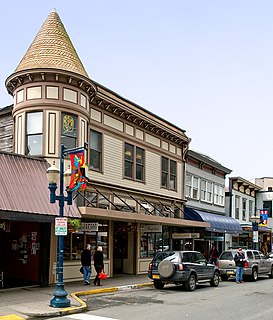
The Alaska Steam Laundry is a historic commercial building at 174 South Franklin Street in Juneau, Alaska. It is a Late Victorian wood-frame structure, with a prominent turret that has a conical roof. Built in 1901, it is a well-preserved element of the transition of Juneau from a mining camp to a more cosmopolitan city. It was built by E. R. Jaeger, who envisioned the laundry as a profitable business serving single miners working the nearby gold mines. The laundry facilities were housed on the ground floor, with residences and office space above. The laundry operated here until 1929, when it was moved to new premises in the city, and this building was converted to other commercial uses.
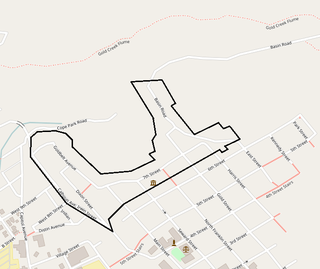
The Chicken Ridge Historic District is a residential historic district in Juneau, Alaska. It is located in an area long known as Chicken Ridge, and has since the early 20th century been one of Juneau's finest neighborhoods. It includes properties along Seventh Street, Basin Road above Seventh, Goldbelt Avenue, Dixon Street, and Main Street above Sixth. Most of the district's 75 contributing and 26 non-contributing properties are Craftsman in style, although the Tudor Revival and Colonial Revival are also well represented.
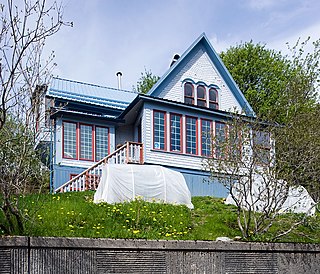
The J. M. Davis House is a historic house at 202 6th Street in Juneau, Alaska. This two-story wood-frame house was built in 1892, when Juneau was little more than a gold mining camp, and remains one of its most elegant homes of the period, as well as one of its oldest buildings. The builder, J. M. Davis, was a miner whose wife was a wealthy English artist. Their son, Trevor Davis, was a noted Alaskan landscape photographer; the house has also served as the official residence of the local US Coast Guard Admiral.
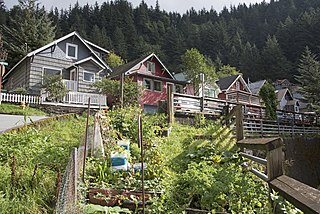
The Fries Miners' Cabins are a group of six small houses located on the 500 block of Kennedy Street, in the Starr Hill neighborhood adjacent to downtown Juneau, Alaska. The six were built as essentially identical structures in 1913 to house miners working in the local gold mines. The houses are 1+1⁄2-story structures of wood-frame construction, and are in the Craftsman style popular at the time. Of the more than 200 miner houses built during Juneau's gold boom, these are among the few that survive.

The Ernest Gruening Cabin is a historic rural cabin in Juneau, Alaska, United States, and the centerpiece of Ernest Gruening State Historical Park. It is a 1+1⁄2-story wood-frame structure located 26 miles (42 km) north of the city on the Glacier Highway. It is the only building associated with the life of Ernest Gruening, governor of the Alaska Territory 1939–53, other than the Alaska Governor's Mansion. The cabin was built on land Gruening leased from the United States Forest Service, and was built by local laborers including Gruening's son Hunt. The cabin measures 24 feet (7.3 m) by 28 feet (8.5 m), with a gable roof and a large fieldstone chimney. Its exterior is finished in shiplap siding milled to resemble unfinished logs. The interior consists of a single large chamber, with a circular stairway leading to a sleeping loft above. The kitchen area is set apart from the rest of the space by different flooring, an alteration by Gruening's grandson. The property is now a state historic site.

The Jualpa Mining Camp, also known as the Last Chance Basin Camp, is a former gold mining camp, just outside the city of Juneau, Alaska. Its main building is now operated as the Last Chance Mining Museum by the Gastineau Historical Society. The camp was located on the southern banks of Gold Creek, about 1 mile (1.6 km) north of Juneau, near what is now the end of Basin Road. The camp was the site of one of the largest gold finds in the Juneau mining district. It was established between 1910 and 1913 by the Alaska-Juneau Gold Mining Company and operated until 1944, producing more than $80 million worth of gold. The largest surviving structure of the camp is its air compressor building, which was 84 feet (26 m) long, and still houses the compressor used by the company. Also surviving are a variety of railroad-related resources, which the company used to bring or to its mill on the Gastineau channel, an electrical transformer house, powder magazine, and cable hoist.

The Juneau Downtown Historic District encompasses the historic commercial heart of the city of Juneau, Alaska. It extends along South Franklin Street, from the cruise terminal in the south to Second Street in the north, and westward along Second and Front Streets to Main Street. This area was the center of Juneau's economic activity from its founding in 1880 as a gold mining camp, through its growth into an urbanized area in the early 20th century, including its eventual designation as the territorial capital in 1906. In the early days of the gold mining camp business was centered in the area bounded by Front, Main and South Franklin, with maritime activities in particular eventually extending further south along the shore of the Gastineau Channel by making land using mine tailings. The early buildings have relatively utilitarian architecture, while those of the early 20th century are somewhat more ornate, with Late Victorian details. Notable buildings from this period include the Alaska Steam Laundry and the Valentine Building.

The Juneau-Douglas City Museum is located at the corner of 4th and Main, opposite the Alaska State Capitol in Juneau, Alaska. It occupies a building which was built in 1950–51 to house the Juneau Memorial Library. It is a two-story Classical Revival structure built out of concrete with red marble trim elements. A gable-roofed projecting section at the center of the long wall provides the main entrance, which is recessed in an opening the full height to the pediment. This projecting section is flanked by banks of five metal-framed awning windows. The northeast facade has a gable pediment similar to that of the entry projection, below which is a large rectangular window, behind which a stained glass decoration has been installed. The building served the city as its library until the 1980s, at which time it was repurposed to house the city museum.

The MacKinnon Apartments are a historic apartment building at 236 Third Street in Juneau, Alaska. It is a three-story wood-frame structure, finished in stucco, with corner quoining and a dentillated cornice. When originally built in 1925, it was 80 feet (24 m) long and housed six single-bedroom and 12 studio apartments. In 1959 another 20 feet (6.1 m) were added, housing another five studio units. The building is a representative of Juneau's boom years in the 1920s, when the local gold rush peaked.
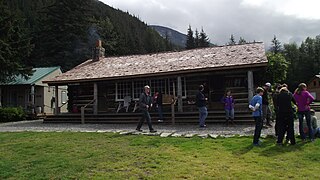
The Twin Glacier Camp, also known as the Twin Glacier Lodge and now Taku Glacier Lodge, is a historic wilderness recreation complex in Juneau Borough, Alaska. It is located on the southern banks of the Taku River, about 30 miles (48 km) from the city of Juneau.

Creek Street is a historic area of Ketchikan, Alaska. The street is actually a boardwalk mounted in stilts on a high slope on the east side of Ketchikan Creek, east of the city's downtown. Creek Street was listed on the National Register of Historic Places in 2014.

The House of Wickersham, also known as the Wickersham State Historic Site, is a historic house at 213 7th Street in the Chicken Ridge area of Juneau, Alaska. It is a historic house museum operated by the state of Alaska, memorializing the life of James Wickersham (1857-1939), an influential political leader in Alaska in the early 20th century. The house, a 2+1⁄2-story frame structure, was built in 1899 by Frank Hammond, owner of a mining company. It was purchased by Wickersham in 1928 and remained his home until his death. The house has been operated, informally at first by Wickersham's niece, as a museum since 1958. The house was purchased by the state in 1984.

The Fairview Inn is a historic hotel building on Main Street in the center of Talkeetna, Alaska, United States. It is a two-story frame structure, with a hip roof. The main block, 36 feet (11 m) square, was built between 1920 and 1923, following the arrival in the area of the Alaska Railroad. The building exterior is little-altered since then; its major modification has been the addition in the 1970s of an addition for owner living quarters. The interior also still follows essentially the same floor plan as when it was built.

Kimball's Store, also known as Kimball Building, was a historic retail establishment at 500 and 504 West 5th Avenue in downtown Anchorage, Alaska. The dry goods store operated at the same site from 1915 to 2002, and its two-story wood-frame building is the only commercial building to survive at its original location from the period of Anchorage's founding. The store was established by Irving L. Kimball, who had been trading in Arctic communities of Alaska since 1897, and was operated afterward by his daughter until her death in 2002.

The Matanuska Colony Community Center, also Palmer Historic District, is a cluster of buildings near the center of Palmer, Alaska that were the centerpiece of the Depression-era Matanuska Valley Colony. This federal rural resettlement program was intended to give needy families resources and land to improve their condition. The colony's buildings were erected beginning in 1935, and those that survive represent a well-preserved example of government community planning. It is centered on a city block bounded by East Dahlia Avenue, South Valley Way, South Denali Street, and East Elmwood Avenue, and extends to the north and south. The buildings on this block are organized around a grassy quadrangle, laid out in 1935. Prominent buildings include the Palmer Depot and three churches, located in the block just southeast of the quadrangle, one of which, the United Protestant Church, is a distinctive log structure. The colony's Central School, now added to several times, houses the offices of the Matanuska-Susitna Borough.

The Belfast Commercial Historic District encompasses two blocks of the central business district of Belfast, Maine. This area includes the best-preserved and most architecturally interesting commercial buildings of the city's mid-to-late 19th century development, when it was the leading port on Penobscot Bay. It extends along Main Street from the major intersection and Church Street north to Washington Street. It was listed on the National Register of Historic Places in 1980, and is entirely contained within the larger Belfast Historic District.

